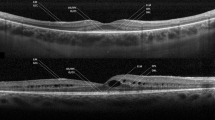Abstract
Purpose
To evaluate the photoreceptor inner and outer segment layer thickness in eyes with MEWDS.
Design
Prospective, non-comparative, observational case series. The follow-up duration was 4 months.
Methods
Four women were diagnosed with unilateral MEWDS. The ages of the patients were 25, 24, 35, and 40 years. The retinal microstructure was assessed by spectral-domain optical coherence tomography (SD-OCT). The thickness of the photoreceptor inner (IS) and outer (OS) segments and sum of them (IS + OS) at the fovea were analyzed.
Results
The visual acuity was reduced in three of four eyes at the acute phase. SD-OCT showed that the border of IS and OS (IS/OS) line and the cone outer segment tips (COST) line in the macula area were not detected in all four eyes. The IS + OS thickness was 50.3 ± 5.6 μm and that of the healthy fellow eyes was 73.5 ± 7.0 μm (n = 4 eyes). The thickness of the IS was 27.8 ± 2.6 μm and that of the OS was 45.8 ± 7.3 μm. In all eyes, there was a spontaneous improvement of the visual acuity. SD-OCT showed a recovery of only the IS/OS line in the macular area, but the COST line was not visible in three cases. The mean IS + OS thickness increased to 56.0 ± 7.9 μm (n = 4), IS = 26.0 ± 2.0 μm (n = 3), and OS = 30.1 ± 8.7 μm (n = 3) in the early recovery phase, and to 64.8 ± 9.3 μm (n = 4), IS = 28.5 ± 1.7 μm (n = 4), and OS = 36.3 ± 7.9 μm (n = 4) in the late recovery phase. The mean inner and outer segment thickness remained unchanged in the fellow eyes.
Conclusion
Eyes with MEWDS have changes in the photoreceptor microstructures. The change in the IS + OS thickness during the natural recovery course might be due to an increase in the OS length.






Similar content being viewed by others

References
Jampol LM, Sieving PA, Pugh D, Fishman GA, Gilbert H (1984) Multiple evanescent white dot syndrome. I. Clinical findings. Arch Ophthalmol 102:671–674
Sieving PA, Fishman GA, Jampol LM, Pugh D (1984) Multiple evanescent white dot syndrome. II. Electrophysiology of the photoreceptors during retinal pigment epithelial disease. Arch Ophthalmol 102:675–679
Li D, Kishi S (2009) Restored photoreceptor outer segment damage in multiple evanescent white dot syndrome. Ophthalmology 116:762–770
Nguyen MH, Witkin AJ, Reichel E, Ko TH, Fujimoto JG, Schuman JS, Duker JS (2007) Microstructural abnormalities in MEWDS demonstrated by ultrahigh resolution optical coherence tomography. Retina 27:414–418
Spaide RF, Koizumi H, Freund KB (2008) Photoreceptor outer segment abnormalities as a cause of blind spot enlargement in acute zonal occult outer retinopathy-complex diseases. Am J Ophthalmol 146:111–120
Forooghian F, Stetson PF, Gross NE, Meyerle CB (2010) Quantitative assessment of photoreceptor recovery in atypical multiple evanescent white dot syndrome. Ophthalmic Surg Lasers Imaging 41(Suppl):S77–S80
Gross NE, Yannuzzi LA, Freund KB, Spaide RF, Amato GP, Sigal R (2006) Multiple evanescent white dot syndrome. Arch Ophthalmol 124:493–500
Marmor MF, Fulton AB, Holder GE, Miyake Y, Brigell M, Bach M (2009) International society for clinical electrophysiology of vision. ISCEV standard for full-field clinical electroretinography (2008 update). Doc Ophthalmol 118:69–77
Hood DC, Bach M, Brigell M, Keating D, Kondo M, Lyons JS, Marmor MF, McCulloch DL, Palmowski-Wolfe AM (2012) International society for clinical electrophysiology of vision. ISCEV standard for clinical multifocal electroretinography (mfERG) (2011 edition). Doc Ophthalmol 124:1–13
Yannuzzi LA (2010) Inflammation. In: The retinal atlas. Elsevier, New York, pp 238–245
Hayakawa K, Ishikawa M, Yamaki K (2004) Ultrastructural changes in rat eyes with experimental Vogt–Koyanagi–Harada disease. Jpn J Ophthalmol 48:222–227
Yamaki K, Takiyama N, Itho N, Mizuki N, Seiya M, Sinsuke W, Hayakawa K, Kotani T (2005) Experimentally induced Vogt–Koyanagi–Harada disease in two Akita dogs. Exp Eye Res 80:273–280
Aoyagi R, Hayashi T, Masai A, Mitooka K, Gekka T, Kozaki K, Tsuneoka H (2012) Subfoveal choroidal thickness in multiple evanescent white dot syndrome. Clin Exp Optom 95:212–217
Shiono A, Kogo J, Klose G, Takeda H, Ueno H, Tokuda N, Inoue J, Matsuzawa A, Kayama N, Ueno S, Takagi H (2013) Photoreceptor outer segment length: a prognostic factor for idiopathic epiretinal membrane surgery. Ophthalmology 120:788–794
Matsumoto H, Kishi S, Otani T, Sato T (2008) Elongation of photoreceptor outer segment in central serous chorioretinopathy. Am J Ophthalmol 145:162–168
Boretsky A, Mirza S, Khan F, Motamedi M, van Kuijk FJ (2013) High-resolution multimodal imaging of multiple evanescent white dot syndrome. Ophthalmic Surg Lasers Imaging Retina 44:296–300
Heussen FM, Ouyang Y, McDonnell EC, Narala R, Ruiz-Garcia H, Walsh AC, Sadda SR (2012) Comparison of manually corrected retinal thickness measurements from multiple spectral-domain optical coherence tomography instruments. Br J Ophthalmol 96:380–385
Acknowledgments
Funding/support
Support of this study was provided by Researches on Sensory and Communicative Disorders from the Ministry of Health, Labor, and Welfare, Japan.
Disclosure statement
No author has a financial or proprietary interest in any material or method mentioned.
Conflict of interest
None
Data access and responsibility
The corresponding author (KShinoda) has full access to all of the data in the study, and takes responsibility for the integrity of the data and the accuracy of the data analysis.
Contributions of authors
Conception and design of study (R.A., I.K., K.Shinoda); conduct of study (R.A., I.K.,Y.I., K.Shinoda); collection of data (K.Shinoda.,Y.I., K.Seki., M.I., A.Mizota); analysis and interpretation of data (R.A., I.K.,Y.I., K.Shinoda); preparation of the manuscript (Y.I., K.Shinoda); critical revision (Y.I., CS.M.); obtain funding (K.Shinoda, A.Mizota.); literature search (K.Shinoda, Y.I.); administrative support (M.I., A.Murakami, A.Mizota.); and review and approval of the manuscript (R.A., I.K.,Y.I., K.Shinoda., CS.M., K.Seki. M.I.,A.Murakami., A.Mizota.)
Author information
Authors and Affiliations
Corresponding author
Rights and permissions
About this article
Cite this article
Arai, R., Kimura, I., Imamura, Y. et al. Photoreceptor inner and outer segment layer thickness in multiple evanescent white dot syndrome. Graefes Arch Clin Exp Ophthalmol 252, 1645–1651 (2014). https://doi.org/10.1007/s00417-014-2747-7
Received:
Revised:
Accepted:
Published:
Issue Date:
DOI: https://doi.org/10.1007/s00417-014-2747-7



